[1,2,5]Thiadiazolo[3,4-d]Pyridazine as an Internal Acceptor in the D-A-π-A Organic Sensitizers for Dye-Sensitized Solar Cells
Abstract
:1. Introduction
2. Results and Discussion
2.1. Synthesis and Characterization
2.2. Photophysical and Electrochemical Properties
2.3. DSSC Performance
3. Experimental Section
3.1. Materials and Reagents
3.2. Analytical Instruments
3.3. General Procedure for Fabrication and Characterization of DSSCs
3.4. Detailed Experimental Procedures and Characterization Data
3.4.1. Optical Characterization
3.4.2. Electrochemical Characterization
3.4.3. Synthesis and Characterization of Compounds
General procedure for the of cross-coupling reaction of mono-adducts 3(a–c), 4, and stannane 6.
General procedure for hydrolysis of ethers 7(a–g).
4. Conclusions
Supplementary Materials
Author Contributions
Funding
Acknowledgments
Conflicts of Interest
References
- Oregan, B.; Grätzel, M. A low-cost, high-efficiency solar cell based on dye sensitized colloidal TiO2 films. Nature 1991, 353, 737–739. [Google Scholar] [CrossRef]
- Qin, C.; Numata, Y.; Zhang, S.; Yang, X.; Islam, A.; Zhang, K.; Chen, H.; Han, L. Novel Near-Infrared Squaraine Sensitizers for Stable and Efficient Dye-Sensitized Solar Cells. Adv. Funct. Mater. 2014, 24, 3059–3066. [Google Scholar] [CrossRef]
- Yella, A.; Lee, H.; Tsao, H.N.; Yi, C.; Chandiran, A.K.; Nazeeruddin, M.K.; Diau, E.W.; Yeh, C.; Zakeeruddin, S.M.; Gratzel, M. Porphyrin-Sensitized Solar Cells with Cobalt(II/III)-Based Redox Electrolyte Exceed 12 Percent Efficiency. Science 2011, 334, 629–634. [Google Scholar] [CrossRef] [PubMed]
- Knyazeva, E.A.; Rakitin, O.A. Influence of structural factors on the photovoltaic properties of dye-sensitized solar cells. Russ. Chem. Rev. 2016, 85, 1146–1183. [Google Scholar] [CrossRef]
- Zhao, W.C.; Li, S.S.; Yao, H.F.; Zhang, S.Q.; Zhang, Y.; Yang, B.; Hou, J.H. Molecular Optimization Enables over 13% Efficiency in Organic Solar Cells. J. Am. Chem. Soc. 2017, 139, 7148–7151. [Google Scholar] [CrossRef]
- Zhao, W.; Qian, D.; Zhang, S.; Li, S.; Inganas, O.; Gao, F.; Hou, J. Fullerene-Free Polymer Solar Cells with over 11% Efficiency and Excellent Thermal Stability. Adv. Mater. 2016, 28, 4734–4739. [Google Scholar] [CrossRef]
- Du, J.; Du, Z.; Hu, J.; Pan, Z.; Shen, Q.; Sun, J.; Long, D.; Dong, H.; Sun, L.; Zhong, X.; et al. Zn-Cu-in-Se Quantum Dot Solar Cells with a Certified Power Conversion Efficiency of 11.6%. J. Am. Chem. Soc. 2016, 138, 4201–4209. [Google Scholar] [CrossRef]
- Pan, Z.; Rao, H.; Mora-Seró, I.; Bisquert, J.; Zhong, X. Quantum dot-sensitized solar cells. Chem. Soc. Rev. 2018, 47, 7659–7702. [Google Scholar] [CrossRef]
- Rong, Y.; Hu, Y.; Mei, A.; Tan, H.; Saidaminov, M.I.; Seok, S.I.; McGehee, M.D.; Sargent, E.H.; Ha, H. Challenges for commercializing perovskite solar cells. Science 2018, 361, eaat8235. [Google Scholar] [CrossRef]
- Jena, A.K.; Kulkarni, A.; Miyasaka, T. Halide Perovskite Photovoltaics: Background, Status, and Future Prospects. Chem. Rev. 2019, 119, 3036–3103. [Google Scholar] [CrossRef]
- Saliba, M.; Correa-Baena, J.-P.; Wolff, C.M.; Stolterfoht, M.; Phung, N.; Albrecht, S.; Neher, D.; Abate, A. How to Make over 20% Efficient Perovskite Solar Cells in Regular (n-i-p) and Inverted (p-i-n) Architectures. Chem. Mater. 2018, 30, 4193–4201. [Google Scholar] [CrossRef]
- Meng, L.; Zhang, Y.; Wan, X.; Li, C.; Zhang, X.; Wang, Y.; Ke, X.; Xiao, Z.; Ding, L.; Xia, R.; et al. Organic and solution-processed tandem solar cells with 17.3% efficiency. Science 2018, 361, 1094–1098. [Google Scholar] [CrossRef]
- Cui, Y.; Yao, H.; Gao, B.; Qin, Y.; Zhang, S.; Yang, B.; He, C.; Xu, B.; Hou, J. Fine-tuned photoactive and interconnection layers for achieving over 13% efficiency in a fullerene-free tandem organic solar cell. J. Am. Chem. Soc. 2017, 139, 7302–7309. [Google Scholar] [CrossRef]
- Liang, M.; Chen, J. Arylamine organic dyes for dye-sensitized solar cells. Chem. Soc. Rev. 2013, 42, 3453–3488. [Google Scholar] [CrossRef] [PubMed]
- Yang, J.B.; Ganesan, P.; Teuscher, J.; Moehl, T.; Kim, Y.J.; Yi, C.Y.; Comte, P.; Pei, K.; Holcombe, T.W.; Nazeeruddin, M.K.; et al. Influence of the donor size in D-π-A organic dyes for dye-sensitized solar cells. J. Am. Chem. Soc. 2014, 136, 5722–5730. [Google Scholar] [CrossRef]
- Hung, W.; Liao, Y.; Lee, T.; Ting, Y.; Ni, J.; Kao, W.; Lin, J.T.; Wei, T.; Yen, Y. Eugenic Metal-Free Sensitizers with Double Anchors for High Performance Dye-Sensitized Solar Cells. Chem. Commun. 2015, 51, 2152–2155. [Google Scholar] [CrossRef]
- Li, L.L.; Diau, E.W.G. Porphyrin-sensitized solar cells. Chem. Soc. Rev. 2013, 42, 291–304. [Google Scholar] [CrossRef]
- Huang, Z.-S.; Hua, T.; Tian, J.; Wang, L.; Meier, H.; Cao, D. Dithienopyrrolobenzotriazole-based organic dyes with high molar extinction coefficient for efficient dye-sensitized solar cells. Dyes Pigm. 2016, 125, 229–240. [Google Scholar] [CrossRef]
- Fischer, M.K.R.; Wenger, S.; Wang, M.; Mishra, A.; Zakeeruddin, S.M.; Grätzel, M.; Bäuerle, P. D-π-A sensitizers for dye-sensitized solar cells: linear vs branched oligothiophenes. Chem. Mater. 2010, 22, 1836–1845. [Google Scholar] [CrossRef]
- Ganesan, P.; Yella, A.; Holcombe, T.W.; Gao, P.; Rajalingam, R.; Al-Muhtaseb, S.A.; Grätzel, M.; Nazeeruddin, M.K. Unravel the impact of anchoring groups on the photovoltaic performances of diketopyrrolopyrrole sensitizers for dye-sensitized solar cells. ACS Sustain. Chem. Eng. 2015, 3, 2389–2396. [Google Scholar] [CrossRef]
- Zhu, W.H.; Wu, Y.Z.; Wang, S.T.; Li, W.Q.; Li, X.; Chen, J.; Wang, Z.S.; Tian, H. Organic D-A-π-A Solar Cell Sensitizers with Improved Stability and Spectral Response. Adv. Funct. Mater. 2011, 21, 756–763. [Google Scholar] [CrossRef]
- He, J.; Wu, W.; Hua, J.; Jiang, Y.; Qu, S.; Li, J.; Long, Y.; Tian, H. Bithiazole-bridged dyes for dye-sensitized solar cells with high open circuit voltage performance. J. Mater. Chem. 2011, 21, 6054–6062. [Google Scholar] [CrossRef]
- Wu, Y.; Zhu, W. Organic sensitizers from D-π-A to D-A-π-A: Effect of the internal electron-withdrawing units on molecular absorption, energy levels and photovoltaic performances. Chem. Soc. Rev. 2013, 42, 2039–2058. [Google Scholar] [CrossRef]
- Qu, S.; Qin, C.; Islam, A.; Wu, Y.; Zhu, W.; Hua, J.; Tian, H.; Han, L. A novel D-A-π-A organic sensitizer containing a diketopyrrolopyrrole unit with a branched alkyl chain for highly efficient and stable dye-sensitized solar cells. Chem. Commun. 2012, 48, 6972–6974. [Google Scholar] [CrossRef]
- Huang, Z.S.; Zang, X.F.; Hua, T.; Wang, L.; Meier, H.; Cao, D. 2,3-Dipentyldithieno[3,2-f:2′,3′-h]quinoxaline-Based organic dyes for efficient dye-sensitized solar cells: effect of π-bridges and electron donors on solar cell performance. ACS Appl. Mater. Interfaces. 2015, 7, 20418–20429. [Google Scholar] [CrossRef]
- Knyazeva, E.A.; Wu, W.; Chmovzh, T.N.; Robertson, N.; Woollins, J.D.; Rakitin, O.A. Dye-sensitized solar cells: Investigation of D-A-π-A organic sensitizers based on [1,2,5]selenadiazolo[3,4-c]pyridine. Sol. Energy 2017, 144, 134–143. [Google Scholar] [CrossRef]
- Cui, Y.; Wu, Y.Z.; Lu, X.F.; Zhang, X.; Zhou, G.; Miapeh, F.B.; Zhu, W.H.; Wang, Z.S. Incorporating Benzotriazole Moiety to Construct D-A-π-A Organic Sensitizers for Solar Cells: Significant Enhancement of Open-Circuit Photovoltage with Long Alkyl Group. Chem. Mater. 2011, 23, 4394–4401. [Google Scholar] [CrossRef]
- Zhu, H.; Liu, B.; Liu, J.; Zhang, W.; Zhu, W.-H. D-A-π-A featured sensitizers by modification of auxiliary acceptor for preventing “trade-off” effect. J. Mater. Chem. C 2015, 3, 6882–6890. [Google Scholar] [CrossRef]
- Ying, W.; Guo, F.; Li, J.; Zhang, Q.; Wu, W.; Tian, H.; Hua, J. Series of new D-A-π-A organic broadly absorbing sensitizers containing isoindigo unit for highly efficient dyesensitized solar cells. ACS Appl. Mater. Interfaces 2012, 4, 4215–4224. [Google Scholar] [CrossRef]
- Lua, F.; Yanga, G.; Xua, Q.; Zhanga, J.; Zhanga, B.; Feng, Y. Tailoring the benzotriazole (BTZ) auxiliary acceptor in a D-A′-π-A type sensitizer for high performance dye-sensitized solar cells (DSSCs). Dyes Pigm. 2018, 158, 195–203. [Google Scholar] [CrossRef]
- Katono, M.; Wielopolski, M.; Marszalek, M.; Bessho, T.; Moser, J.-E.; Humphry-Baker, R.; Zakeeruddin, S.M.; Grätzel, M. Effect of Extended π-Conjugation of the Donor Structure of Organic D-A-π-A Dyes on the Photovoltaic Performance of Dye-Sensitized Solar Cells. J. Phys. Chem. C 2014, 118, 16486–16493. [Google Scholar] [CrossRef]
- Wang, X.; Yang, J.; Yu, H.; Li, F.; Fan, L.; Sun, W.; Liu, Y.; Koh, Z.Y.; Pan, J.; Yim, W.-L.; et al. A benzothiazole–cyclopentadithiophene bridged D-A-π-A sensitizer with enhanced light absorption for high efficiency dye-sensitized solar cells. Chem. Commun. 2014, 50, 3965–3968. [Google Scholar] [CrossRef]
- Chmovzh, T.N.; Knyazeva, E.A.; Mikhalchenko, L.V.; Golovanov, I.S.; Amelichev, S.A.; Rakitin, O.A. Synthesis of 4,7-dibromo derivative of ultrahigh electron-deficient [1,2,5]thiadiazolo[3,4-d]pyridazine heterocycle and its cross-coupling reactions, Eur. J. Org. Chem. 2018, 41, 5668–5677. [Google Scholar] [CrossRef]
- Chmovzh, T.N.; Knyazeva, E.A.; Lyssenko, K.A.; Popov, V.V.; Rakitin, O.A. Safe synthesis of 4,7-dibromo[1,2,5]thiadiazolo[3,4-d]pyridazine and its SNAr reactions. Molecules 2018, 23, 2576. [Google Scholar] [CrossRef]
- Oikawa, A.; Kindaichi, G.; Shimotori, Y.; Okimoto, M.; Hoshi, M. Simple preparation of aryltributylstannanes and its application to one-pot synthesis of diaryl ketones. Tetrahedron 2015, 71, 1705–1711. [Google Scholar] [CrossRef]
- Cardona, C.M.; Li, W.; Kaifer, A.E.; Stockdale, D.; Bazan, G.C. Electrochemical Considerations for Determining Absolute Frontier Orbital Energy Levels of Conjugated Polymers for Solar Cell Applications. Adv. Mater. 2011, 23, 2367–2371. [Google Scholar] [CrossRef]
- Oskam, G.; Bergeron, B.V.; Meyer, G.J.; Searson, P.C. Pseudohalogens for Dye-Sensitized TiO2 Photoelectrochemical Cells. J. Phys. Chem. B 2001, 105, 6867–6873. [Google Scholar] [CrossRef]
- Babu, D.D.; Cheema, H.; Elsherbiny, D.; El-Shafei, A.; Adhikari, A.V. Molecular Engineering and Theoretical Investigation of Novel Metal-Free Organic Chromophores for Dye-Sensitized Solar Cells Molecular Engineering and Theoretical Investigation of Novel Metal-Free Organic Chromophores for Dye-Sensitized Solar Cells. Electrochim. Acta 2015, 176, 868–879. [Google Scholar] [CrossRef]
- Akkuratov, A.V.; Troshin, P.A. Conjugated Polymers with Benzothiadiazole, Benzoxadiazole, and Benzotriazole Moieties as Promising Semiconductor Materials for Organic Solar Cells. Polym. Sci. Ser. B 2014, 56, 414–442. [Google Scholar] [CrossRef]
- Koops, S.E.; O’Regan, B.C.; Barnes, P.R.F.; Durrant, J.R. Parameters influencing the efficiency of electron injection in dye-sensitized solar cells. J. Am. Chem. Soc. 2009, 131, 4808–4818. [Google Scholar] [CrossRef]
- Hussain, M.; Islam, A.; Bedja, I.; Gupta, R.K.; Han, L.; El-Shafei, A. A comparative study of Ru(II) cyclometallated complexes versus thiocyanated heteroleptic complexes: thermodynamic force for efficient dye regeneration in dye-sensitized solar cells and how low could it be? Phys. Chem. Chem. Phys. 2014, 16, 14874–14881. [Google Scholar] [CrossRef]
- Hardin, B.E.; Snaith, H.J.; McGehee, M.D. The renaissance of dye-sensitized solar cells. Nature Photonics 2012, 6, 162–169. [Google Scholar] [CrossRef]
- Fuse, S.; Sugiyama, S.; Maitani, M.M.; Wada, Y.; Ogomi, Y.; Hayase, S.; Katoh, R.; Kaiho, T.; Takahashi, T. Elucidating the Structure–Property Relationships of Donor–π-Acceptor Dyes for Dye-Sensitized Solar Cells (DSSCs) through Rapid Library Synthesis by a One-Pot Procedure. Chem. Eur. J. 2014, 20, 10685–10694. [Google Scholar] [CrossRef]
Sample Availability: Samples of the compounds are available from the authors. |

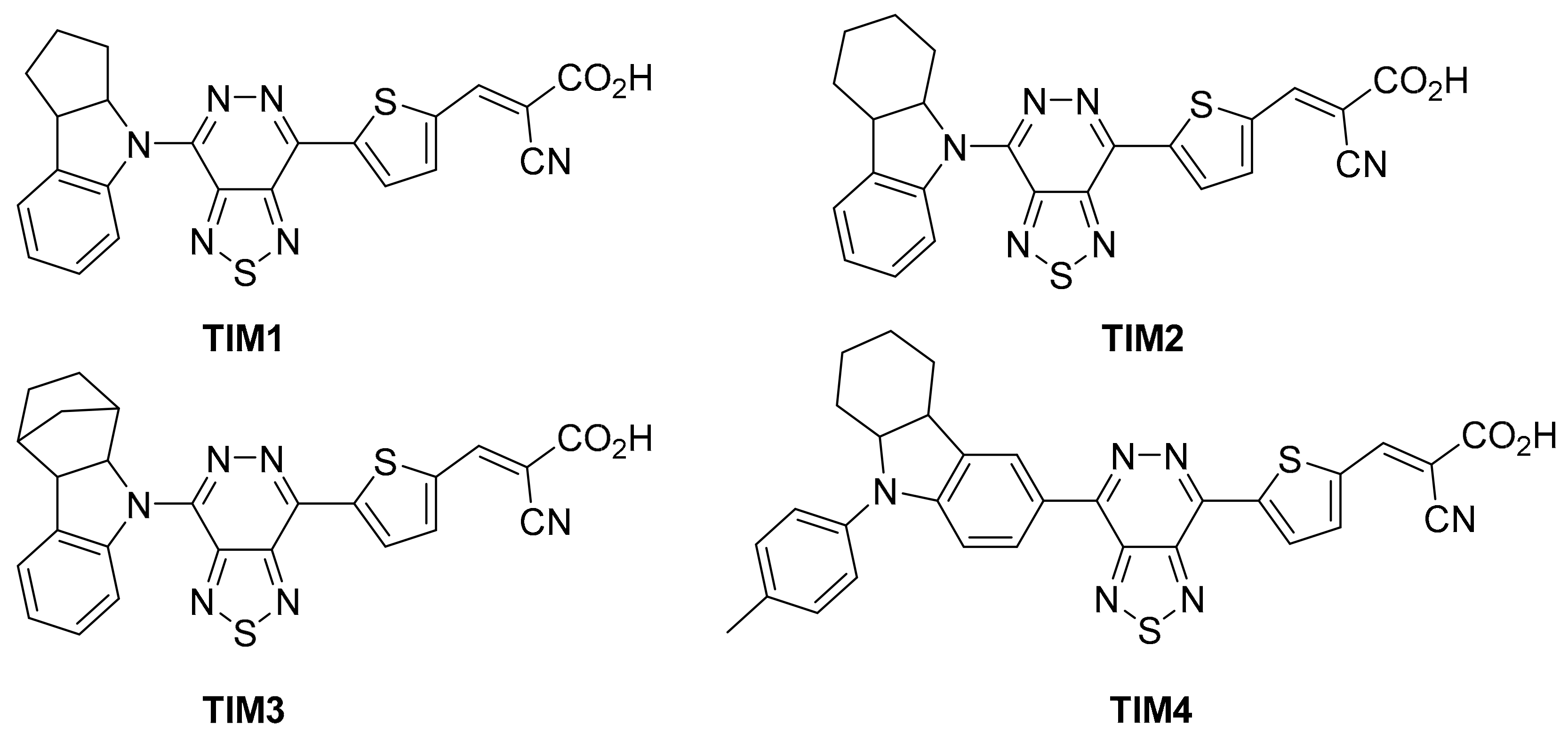
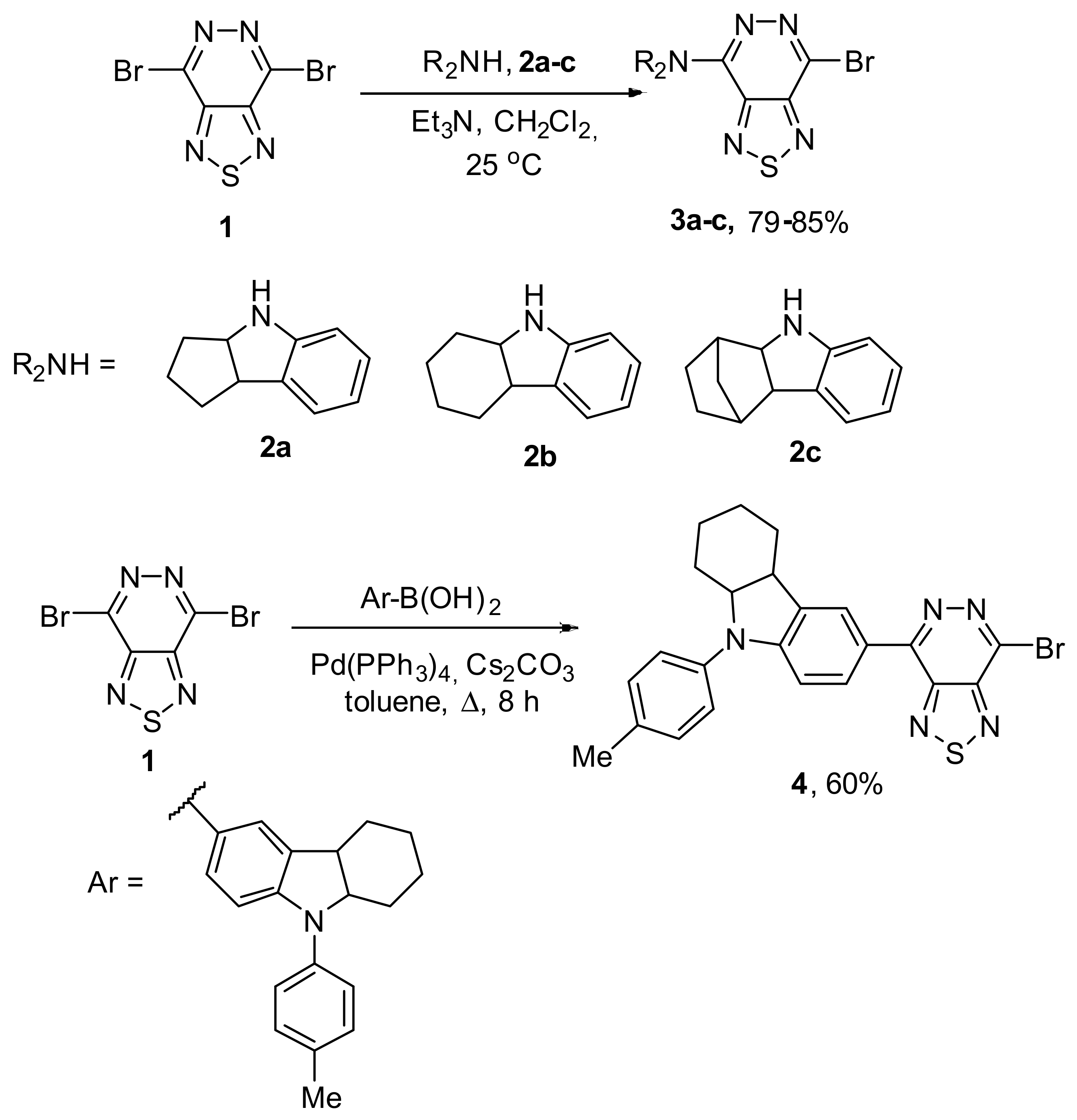
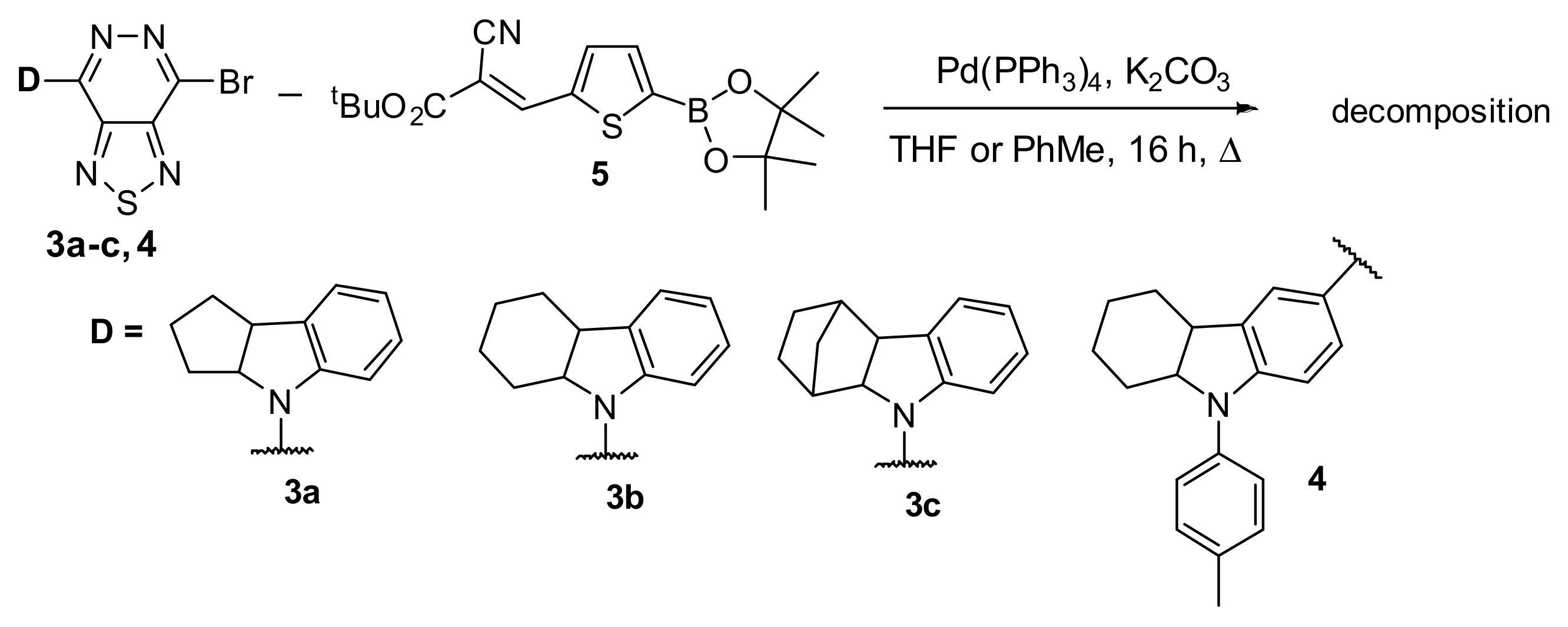


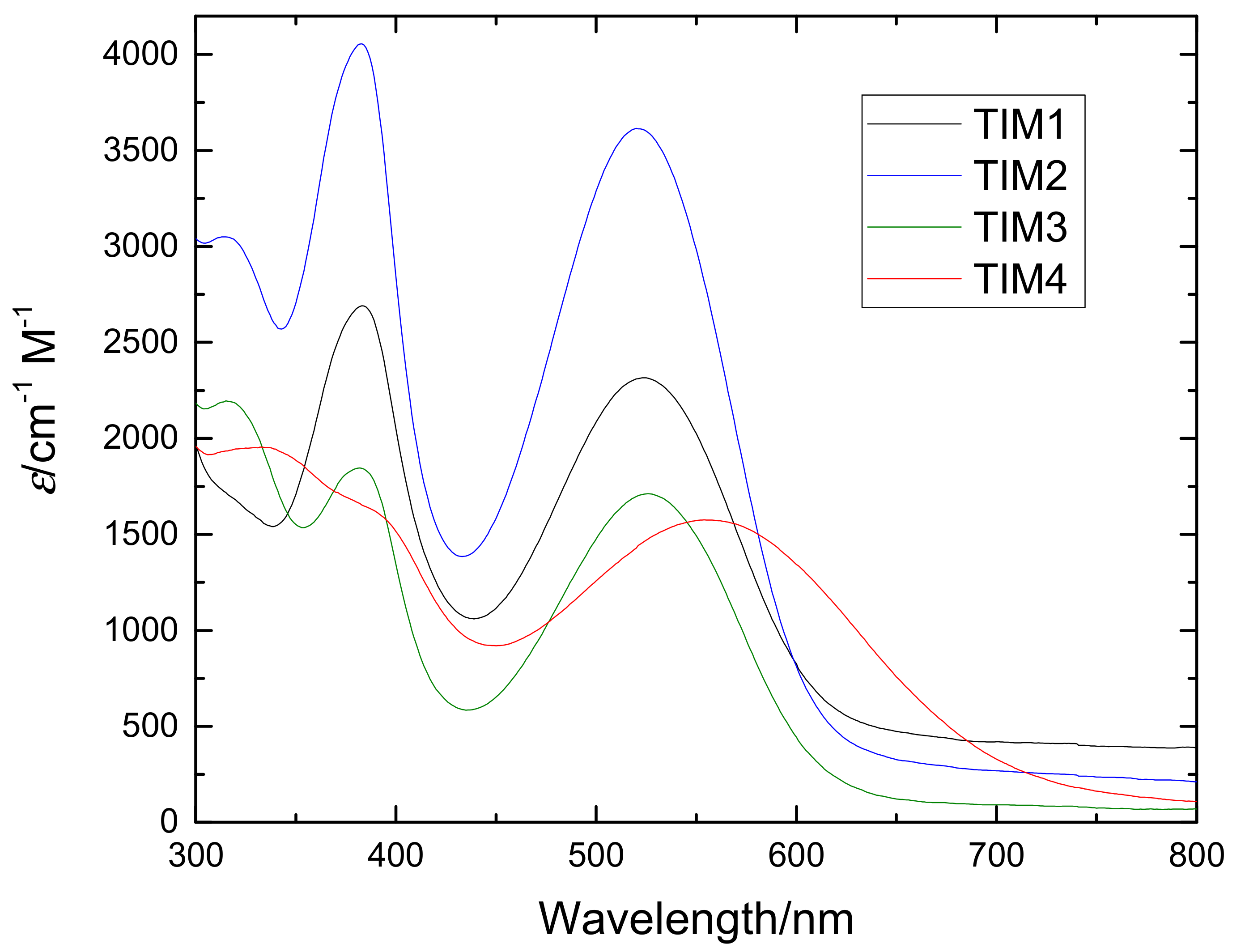
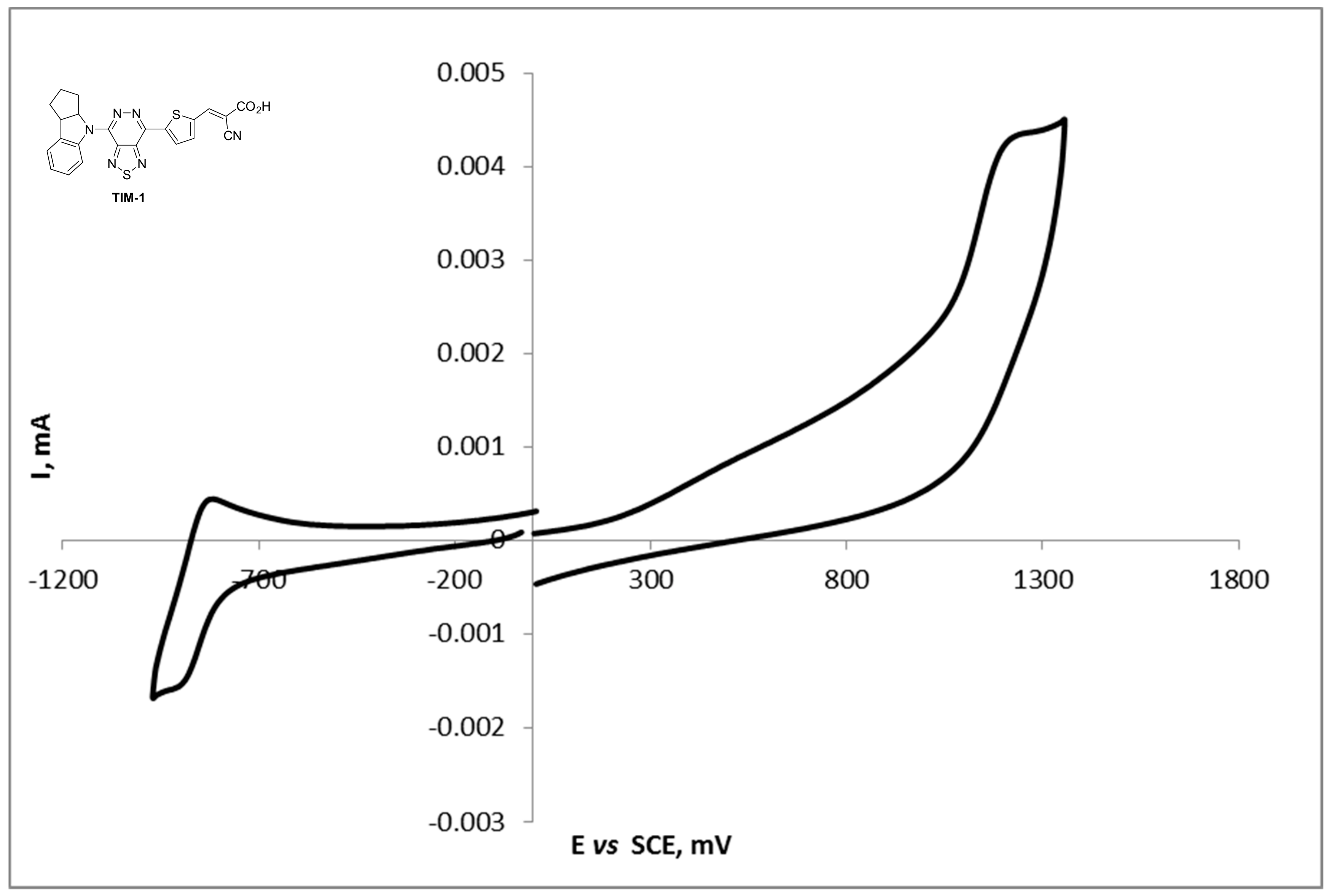


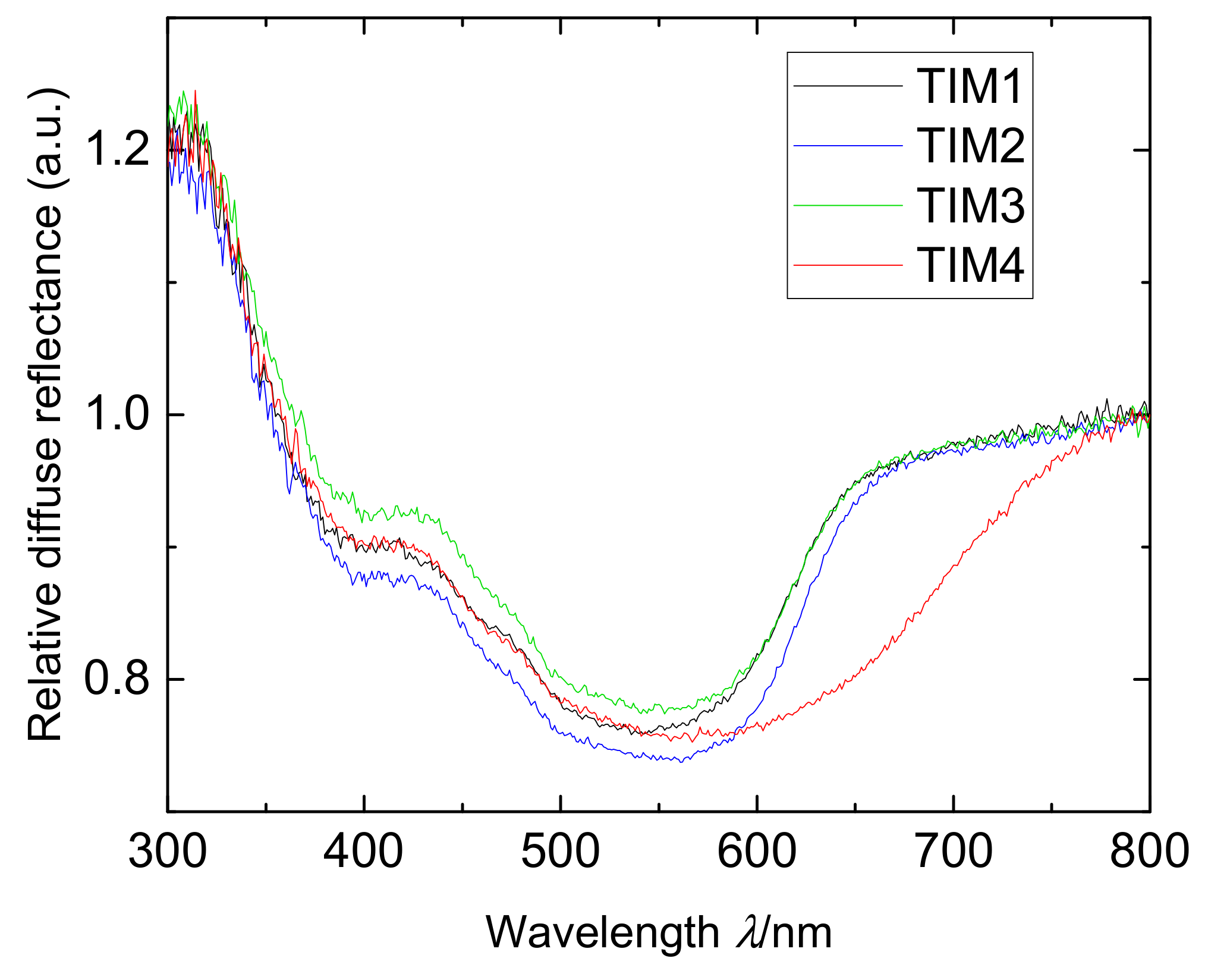

| Dye | λmax1 [nm] a | εmax1 × 103 [M−1·cm−1] a | λmax2 [nm]a | εmax2 × 103 [M−1·cm−1] a | λonset [nm] a | |
|---|---|---|---|---|---|---|
| TIM1 | 383 | 2.7 | 524 | 2.3 | 631 | 1.968 |
| TIM2 | 382 | 4.1 | 520 | 3.6 | 617 | 2.013 |
| TIM3 | 382 | 1.8 | 526 | 1.7 | 620 | 2.003 |
| TIM4 | - | - | 554 | 1.6 | 722 | 1.720 |
| Dye | Eox [V] vs. Fc/Fc+ a | Ered [V] vs Fc/Fc+ a | ЕHOMO [eV] b | ЕLUMO [eV] b | |
|---|---|---|---|---|---|
| TIM1 | 0.54 | −1.28 | −5.64 | −3.82 | −1.82 |
| TIM2 | 0.54 | −1.26 | −5.64 | −3.84 | −1.80 |
| TIM3 | 0.52 | −1.27 | −5.62 | −3.83 | −1.79 |
| TIM4 | 0.21 | −1.10 | −5.31 | −4.00 | −1.31 |
| Dye | VOC [V] | JSC [mA cm−2] | FF | PCE [%] |
|---|---|---|---|---|
| N719 | 0.67 | 16.35 | 0.76 | 8.29 |
| TIM1 | 0.39 | 0.32 | 0.75 | 0.09 |
| TIM2 | 0.37 | 0.23 | 0.71 | 0.06 |
| TIM3 | 0.42 | 0.45 | 0.76 | 0.14 |
| TIM4 | 0.35 | 0.20 | 0.68 | 0.05 |
© 2019 by the authors. Licensee MDPI, Basel, Switzerland. This article is an open access article distributed under the terms and conditions of the Creative Commons Attribution (CC BY) license (http://creativecommons.org/licenses/by/4.0/).
Share and Cite
Chmovzh, T.N.; Knyazeva, E.A.; Tanaka, E.; Popov, V.V.; Mikhalchenko, L.V.; Robertson, N.; Rakitin, O.A. [1,2,5]Thiadiazolo[3,4-d]Pyridazine as an Internal Acceptor in the D-A-π-A Organic Sensitizers for Dye-Sensitized Solar Cells. Molecules 2019, 24, 1588. https://doi.org/10.3390/molecules24081588
Chmovzh TN, Knyazeva EA, Tanaka E, Popov VV, Mikhalchenko LV, Robertson N, Rakitin OA. [1,2,5]Thiadiazolo[3,4-d]Pyridazine as an Internal Acceptor in the D-A-π-A Organic Sensitizers for Dye-Sensitized Solar Cells. Molecules. 2019; 24(8):1588. https://doi.org/10.3390/molecules24081588
Chicago/Turabian StyleChmovzh, Timofey N., Ekaterina A. Knyazeva, Ellie Tanaka, Vadim V. Popov, Ludmila V. Mikhalchenko, Neil Robertson, and Oleg A. Rakitin. 2019. "[1,2,5]Thiadiazolo[3,4-d]Pyridazine as an Internal Acceptor in the D-A-π-A Organic Sensitizers for Dye-Sensitized Solar Cells" Molecules 24, no. 8: 1588. https://doi.org/10.3390/molecules24081588
APA StyleChmovzh, T. N., Knyazeva, E. A., Tanaka, E., Popov, V. V., Mikhalchenko, L. V., Robertson, N., & Rakitin, O. A. (2019). [1,2,5]Thiadiazolo[3,4-d]Pyridazine as an Internal Acceptor in the D-A-π-A Organic Sensitizers for Dye-Sensitized Solar Cells. Molecules, 24(8), 1588. https://doi.org/10.3390/molecules24081588









